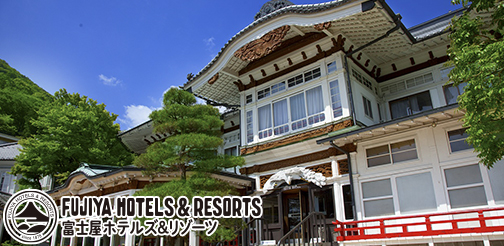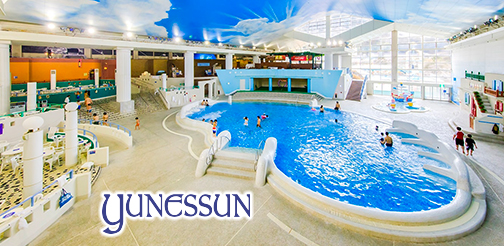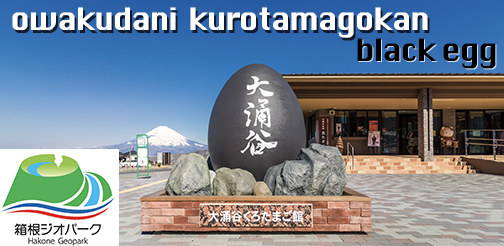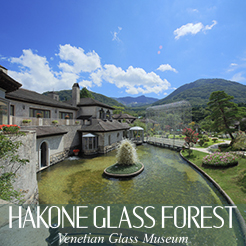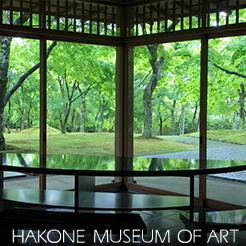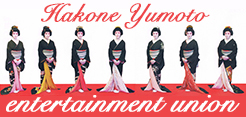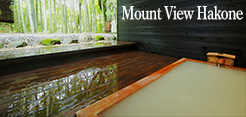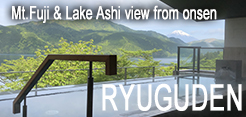The hydrangea is known as “Ajisai” in Japanese and can be written with these character 紫陽花. A literal translation of this flowers name would be “purple sun flower.” This is a good description of the large flowering buds and colors. There are dozens of different hydrangea types and many of them can be found in the Hakone area. Some of the best places to see this beautiful flower are along the Hakone Tozan Railroad, Venetian Glass Museum, Amidaji Temple, and many more.
In Japan, ama-cha, 甘茶, meaning sweet tea, is another herbal tea made from Hydrangea serrata, whose leaves contain a substance that develops a sweet taste. For the fullest taste, fresh leaves are crumpled, steamed, and dried, yielding dark brown tea leaves. Ama-cha is mainly used for kan-butsu-e (the Buddha bathing ceremony) on April 8 every year—the day thought to be Buddha’s birthday in Japan. During the ceremony, Ama-cha is poured over a statue of Buddha and served to people in attendance. A legend has it that on the day Buddha was born, nine dragons poured Amrita over him; ama-cha is substituted for Amrita in Japan. Amrita is described as a nectar, but in ancient Indian texts it symbolized many things, including immortality.
Hydrangea is a genus of 70–75 species of flowering plants native to Asia and the Americas. By far the greatest species diversity is in eastern Asia, notably China, Korea, and Japan. Most are shrubs 1 to 3 meters tall, but some are small trees, and others reachup to 30 m (98 ft) by climbing up trees. They can be either deciduous or evergreen, though the widely cultivated temperate species are all deciduous.
Hydrangea is derived from Greek and means ‘water vessel’ (hydria), in reference to the shape of its seed capsules.The earlier name, Hortensia, is a Latinised version of the French given name Hortense, referring to French astronomer and mathematician Nicole-Reine Hortense Lepaute.
In Hakone, the blooming time varies depending on the altitude (from Yumoto to higher elevations), but in most years, you can enjoy the hydrangeas from around mid-June to mid-July (about a month) (the best time to see them is usually around the end of June) at the following representative spots.
Places to See Ajisai in Hakone
Hakone-Yumoto area (along the Hayakawa River, etc.)
The flowering season around Yumoto starts around mid-June.
In the Hakone Yumoto area, the blooming season starts around mid-June, and you can see hydrangeas in full bloom as shown in the photo (taken last year).
Along the Hakone Tozan Railway (Hydrangea Lane in Ohiradai, etc.)
There are about 10,000 hydrangea plants along the Hakone Tozan Train Line.
The Hakone Tozan Railway is nicknamed the “Hydrangea Train” when the hydrangeas are in bloom. The train “Hydrangea Train” runs at special times in the evening and the flowers a lit up for a special experience. The train can be ridden at anytime, but there are sometimes special events that require a pass for the “Ajisai Densha”.
You can see the hydrangeas blooming so profusely that you can touch the windows of the train at places such as the “Hydrangea Lane in Ohiradai”.
In the evening, you can enjoy the view from Hakone-Yumoto to At night, seven places in the Hakone-yumoto – Gora area are illuminated (nighttime illumination period: April to March).
In the evening, seven locations between Hakone-yumoto and Gora are illuminated and wide variety of hydrangeas bloom near the cruise ship and pirate ship terminals on Lake Ashi as well. Along with the hydrangeas, you can also see famous places such as Lake Ashinoko and Torii gates of Hakone Shrine. The Lake Ashi area is a wonderful place ot take a walk and enjoy nature, history, and tasty treats during your time in Hakone.
The Hakone Open-Air Museum
In the 70,000 square meter site, there are about 120 sculptures on display. In addition to the 120 sculptures on display, the museum is also home to about 500 hydrangea plants, including the Hydrangea japonica, Hydrangea macrophylla and Hydrangea macrophylla. Hakone was chosen as the site for this world famous outdoor sculpture museum for the mountain views and surrounding natural environment. The blooming hydrangea and displayed works by artists like Henry Moore, Rodin, Bourdelle, Armitage, Rosso and many more is a wonderful combination of the beauty of man and nature.
Hakone Glass no Mori Art Museum
The Hakone Glass no Mori Art Museum’s “Hydrangea Garden” features 4,500 plants of 70 varieties, from early to late blooming. The white hydrangea “Annabelle” blooming all over the garden is a sight to behold between the glimmering pieces of glass art displayed on the grounds of this museum in Sengokuhara. You can also enjoy vine hydrangeas that crawl up the walls of buildings with views of the steaming vents of Owakudani in the background.
Amidaji Temple
This hidden mountain temple is a secret to many and is also known as the “Hydrangea Temple” because of the large number of flowers blooming in July. The temple is accessed from TOnosawa Station on the Hakone Tozan Railway and by walking up the hiking path leading straight up the mountain. The walk from the station will take you about 15 minutes and transport you to another time. This hidden temple has many legends and historical figues attached to its history. The temple is a location for the famous Tale of Hatsuhana. Hatsuhana is the main heroine in a legend about a devoted woman who fulfills an act of revenge for her crippled husband. The story has many of the characteristics respected by the Japanese, piety, devotion, honor, respect, patience. The temple was even the sanctuary for the wife of the last Tokugawa Shogun who gave power back to the Emperor in 1868 which led to the industrialization and ascension of Japan after it emerged from the age of the Samurai.
MAZDA Turnpike Hakone
Hakone is a large and expansive area and can also be enjoyed by the car enthusiast. Hakone is a famous area for people who follow Japanese car culture because of the many winding roads up the mountains make it perfect to test your driving skills. Blue, pink, purple, white and other colorful hydrangeas decorate the side of the road. The Gosho-no-iri parking lot is also called “Hydrangea Plaza”. You can take a rest and enjoy the hydrangeas in the plaza beside the parking lot.
If you are planning to visit Japan or Hakone in June, please consider “hydrangea viewing” as a way to enjoy and enrich your time here.


